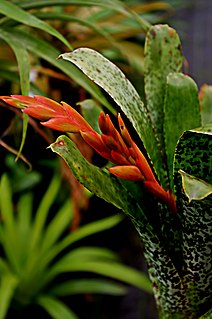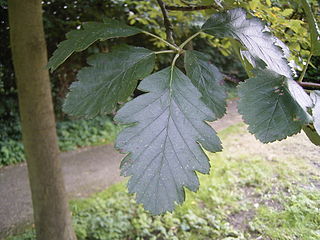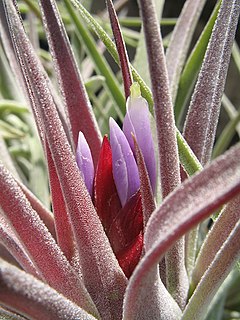
Spanish moss is an epiphytic flowering plant that often grows upon large trees in tropical and subtropical climates. It is native to much of Mexico, Bermuda, the Bahamas, Central America, South America, the Southern United States, West Indies. It has been naturalized in Queensland (Australia). It is known as "grandpas beard" in French Polynesia.

Tillandsia is a genus of around 650 species of evergreen, perennial flowering plants in the family Bromeliaceae, native to the forests, mountains and deserts of northern Mexico and south-eastern United States, Mesoamerica and the Caribbean to mid Argentina. Their leaves, more or less silvery in color, are covered with specialized cells (trichomes) capable of rapidly absorbing water that gathers on them.

The lesser siren is a species of aquatic salamander native to the eastern United States and northern Mexico. They are referred to by numerous common names, including two-legged eel, dwarf siren, and mud eel. The specific epithet intermedia denotes their intermediate size, between the greater siren, Siren lacertina, and the dwarf sirens, Pseudobranchus species.

Tillandsia recurvata, commonly known as small ballmoss or ball moss, is a flowering plant in the family Bromeliaceae that grows upon larger host plants. It grows well in areas with low light, little airflow, and high humidity, which is commonly provided by southern shade trees, often the southern live oak. It is not a parasite like mistletoe, but an epiphyte like its relative Spanish moss.

Tillandsia bartramii, commonly known as Bartram's airplant, is a species of flowering plant in the bromeliad family. It is native to Florida, South Carolina and southern Georgia in the United States as well as Guatemala and Mexico. The name honours William Bartram, an early Florida naturalist.

Tillandsia brenneri is a species of plant in the family Bromeliaceae. It is endemic to Ecuador. Its natural habitats are subtropical or tropical moist lowland forests and subtropical or tropical moist montane forests. It is threatened by habitat loss.

Sorbus intermedia, the Swedish whitebeam, is a species of whitebeam found in southern Sweden, with scattered occurrences in easternmost Denmark (Bornholm), the far southwest of Finland, Estonia, Latvia and northern Poland.

Tillandsia xerographica is a species of bromeliad that is native to southern Mexico, El Salvador, Guatemala and Honduras. The name is derived from the Greek words ξηρός (xeros), meaning "dry", and γραφία (graphia), meaning "writing". It is included in Tillandsia subg. Tillandsia.

Diaphoranthema is a subgenus of the genus Tillandsia.

Tillandsia stricta is a species in the genus Tillandsia. This species is native to South America and Trinidad.

Tillandsia tenuifolia, the narrowleaf airplant, is a species in the genus Tillandsia. This species is widespread across much of South America and the Caribbean islands.

Tillandsia fasciculata, commonly known as the giant airplant or cardinal airplant, is a species of bromeliad that is native to Central America, Mexico, the West Indies, northern South America, and the southeastern United States. Within the United States, this airplant is at risk of extirpation from the Mexican bromeliad weevil, Metamasius callizona.

Tillandsia ionantha, the air plant, is a species in the genus Tillandsia. This species is native to Central America and Mexico. It is also reportedly naturalized in Broward County, Florida.

Tillandsia streptophylla is a species in the genus Tillandsia. This species is native to Central America, Mexico, and the West Indies.

Tillandsia utriculata, commonly known as the spreading airplant or the giant airplant, is a species of bromeliad that is native to Florida and Georgia in the United States, the Caribbean, southern and eastern Mexico, Central America, and Venezuela.
Tillandsia schultzei is a species in the genus Tillandsia. This species is native to Venezuela. The name of the species is given by Hermann August Theodor Harms. Tillandsia schultzei is an evergreen and the height of a perennial reach of 50 to 70 centimeters.
Tillandsia baileyi, commonly known as the reflexed airplant or Bailey's ball moss, is a species of bromeliad that is native to southern Texas in the United States and Tamaulipas in Mexico. It is found along the Gulf of Mexico from Kingsville, Texas to Tampico, Tamaulipas. Preferred host plants for this epiphyte include Southern live oak and Texas ebony.
T. intermedia may refer to:

Tillandsia kammii is a species in the genus Tillandsia that is native to Honduras, but has also been collected in El Salvador. It was first discovered in Honduras in 1977 in the regions of Olancho, Lempira and Copan. Its common name is Kamm's tillandsia.

Sphaeropteris intermedia, synonym Cyathea intermedia, is a species of tree fern endemic to the east coast of New Caledonia. Sphaeropteris intermedia is the world's largest extant species of fern.
















